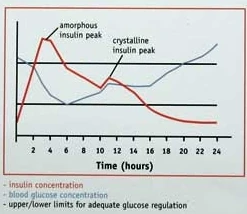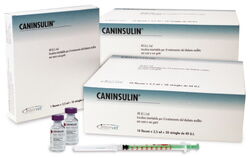| Caninsulin | |
|---|---|
| Lente by Intervet | |
| intermediate-acting | |
| Porcine | |
| U40 | Zinc |
Action in dogs:
| |
| Line: Intervet | |
| Also known as: Vetsulin | |
| Similar to: Betasint Porcine Lente U 40, U80, U100 Lente CHO U 80, Iletin II Lente U 100 [2] Monotard Pork U 100 | |
| Use and Handling: | |
| Shelf Life: 24 months | Type: cloudy |
| When Opened: 28 days room temp. | |
| In Pen: VetPen[3] | |
| Notes: Protect from light and heat Do Not Freeze, [4] Re-suspend Do not use if product does not re-suspend [5] Do not use intravenously [6][7] Intramuscular use not advised, Store Upright between 2-8C, Dilution not advised [8] | |
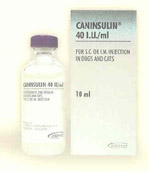
Caninsulin: Intervet's U40 pork lente insulin--this is its name in most of the world.
Caninsulin [9], manufactured by Intervet and known in some countries as Vetsulin [10], is a veterinary porcine lente Intermediate-acting [11] insulin, made up of 30% semilente (short-acting) and 70% ultralente (long acting) insulins.[12]
Caninsulin is FDA-approved for use in dogs and cats, under the trade name Vetsulin. However it was often used in the US legally "off label" for cats, prior to formal approval. [13].
How it works in dogs[]

Vetsulin-Intervet's US name for its U40 pork lente insulin.
The majority of dogs on Caninsulin/Vetsulin (two-thirds) also will require twice-daily [14][15] injections. Intervet says that many dogs stabilize better on twice-daily insulin injections. They also point out that when shots are given twice instead of once daily, there are less hypoglycemia incidents and better blood glucose control. [16][17]
Most vets are also not in favor of once-daily use because it is harder to regulate a dog on once-daily insulin than twice-daily dosing. [18]
Caninsulin/Vetsulin is a lente [19] insulin, which is classed as intermediate, not long acting. Long acting insulins (such as Lantus, [20][21] Ultralente, PZI) have a poor success rate among dogs.
Canine activity graphs[]
Pharmacokinetics graph of Caninsulin. [22] Two peaks are depicted, one for the fast acting semilente insulin, and one for the slow acting Ultralente insulin. However, all dogs do not show two peaks of insulin activity. [23]
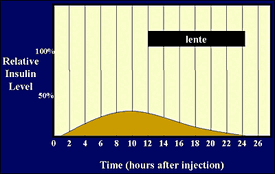
Human time activity profile for lente insulin. This is the same graphic shown on our Lente page.
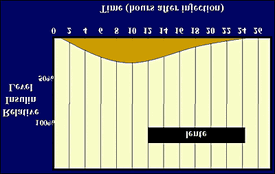
Graph from our Lente page turned upside-down and rotated horizontally; it mirrors the glucose pattern shown in the pharmacokinetics graph.
Once-daily vs twice-daily injections[]
This blood glucose graph of Somogyi rebound shows a dog on once-daily porcine lente injections. You can see how the large insulin dose in once-daily regimens produces a steep low at insulin peak. Note: values are shown in mmol/l (non-US) measurement.
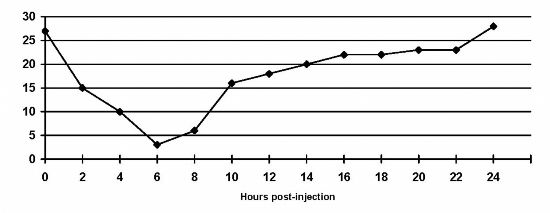
Contrast this with a blood glucose graph with a twice-daily insulin regimen where food and insulin are given on a 12 hour basis. Note: values are shown in mmol/l (non-US) measurement.
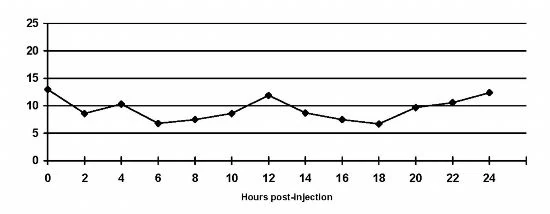
Further Information[]
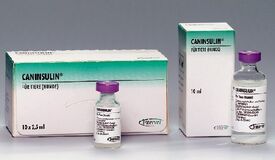
Caninsulin/Vetsulin shown in its two presentation forms: 10ml vial (right) and pack of ten 2.5ml vials(left).
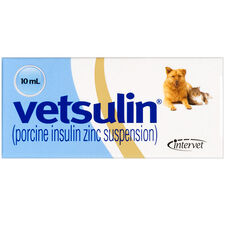
Vetsulin 10 ml vial.
It is a veterinary use prescribed insulin and in most countries must either be purchased directly from your vet or with a prescription.
In Canada, Caninsulin is available OTC, or over the counter [24] online. It is also available online with a prescription [25] in some countries, and may cost less that way.
Caninsulin and Vetsulin in vials can be purchased in three ways: a pack of ten 2.5ml vials, the more traditional 10 ml vial or a single vial of 2.5ml. Cats and and small dogs can get new vials monthly without wasting.
VetPen[]

The new VetPen models from MSD Animal Health.

Technical details for the VetPen.[26]
MSD Animal Health has recently brought a refillable Caninsulin pen onto the market.[27][28] Previously, no pens were designed for use with Lente-type insulins as the glass ball used to resuspend the insulin shattered the large Ultralente crystals present in both Ultralente and Lente insulins.[29] The VetPen is designed to allow resuspension of the insulin without this occurrence. There are two sizes of VetPens. One (tan cap) dispenses insulin doses from 1 to 16 units (IU) per dose in full unit increments. The other (blue cap) dispenses 0.5 (1/2) to 8 unit doses in full or half unit increments. Both pens use 2.7 ml insulin cartridges which hold a total of 108 units (IU) of U40 Caninsulin. The pen uses pen needles that are 29 gauge and 1/2" (12.7 mm) long.[30][31] The pens are operated and maintained like those designed for human use.[3][32][33][34] As with other insulin pens, the. pen and its in-use cartridge do not need to be refrigerated.[30]
Caninsulin/Vetsulin syringes[]

Caninsulin 1/2 cc U40 insulin syringe. Note red needle cap designating this syringe is for U40 insulin; syringes for U100 strength insulins have orange caps.
Because Caninsulin is a U40 insulin, U40 syringes are the most helpful. If you choose to use a U100 syringe, you must do the U40 to U100 conversion. [35] The conversion is not difficult and can give you precision of 0.2 units for those animals needing a more precise dose.

Caninsulin 2ml (2cc) syringes which hold a maximum of 80 IU of U40 insulin.
A 2cc (2ml) syringe was introduced in early 2007 in the UK by Intervet for Caninsulin; this appears to be the only market the larger syringes are sold in. [36][37]
Caninsulin/Vetsulin branded syringes do not appear the same world-wide.
Technical details[]
Caninsulin is a pork-based lente insulin. It is a suspension of crystalline (ultralente) and amorphous (semilente) insulins in a 70/30 ratio, as are all Lente insulins. [38] Iletin II Lente[39] by Eli Lilly and Monotard Pork by Novo Nordisk were pork lente insulins, as is Betasint Porcine Lente U80 and U100. The difference between them is: Vetsulin/Caninsulin is made by Intervet for veterinary use and is a U40 strength insulin--the Lilly and Novo insulins were U100 strength. U40 insulin is more convenient for small animals since it's more dilute and you can therefore give fine doses more easily. Lente CHO is a U80 insulin.
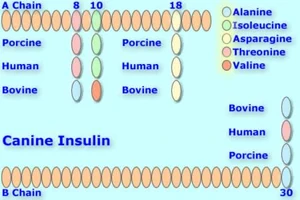
Canine insulin compared with Bovine, Human, & Porcine versions. Up to 2 amino acids differ. Canine and porcine are identical. [40]
Caninsulin is an aqueous suspension of insulin containing 40 IU per ml of highly purified porcine insulin (Lente); 30% is amorphous [41] (non-crystallized) zinc (Semilente) insulin and 70% crystalline (in crystal form) zinc (Ultralente) insulin. The difference between Caninsulin and both Iletin II Lente made by Eli Lilly and Monotard Pork [42] made by Novo Nordisk is this: Caninsulin/Vetsulin is a veterinary insulin of U40 strength. Both Novo's and Lilly's insulins were U100 strength. Beta Laboratorios of Argentina offers Betasint Porcine Lente in U 40, U80 and U 100 strengths while Polfa Tarchomin of Poland offers Lente CHO in U80 strength.
Caninsulin contains porcine insulin. Porcine insulin is identical to canine insulin, [40] but differs from human insulin in respect of one key amino acid. Porcine insulin differs from feline insulin in 3 amino acid positions shown in the table below. [43] Human insulins (i.e. Lantus) differ from from feline insulin by all four key amino acids.
Why Lente doesn't equal 70/30[]
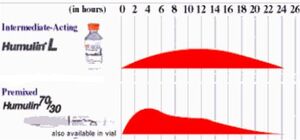
Direct comparison of insulin activity profiles for Lente and 70/30 insulins. The early strong action from the non-suspended R/neutral/normal insulin is seen at the "bump" from hours 0-6.
Let's look at the differences in the two insulins. Lente is comprised of 70 % long-acting Ultralente insulin and 30% short-acting Semilente insulin. So proportions of a long-acting and short-acting insulin are being combined to produce a intermediate-acting insulin. Both Ultralente and Semilente insulin are suspended by adding zinc and the size of their respective insulin crystals. The largest insulin crystals are those of Ultralente, while Semilente contains the smallest, or microcrystals. Simply put, you're combining a long insulin and a short insulin to make an intermediate-acting one.[44]
70/30 insulin starts with 70% NPH/isophane insulin, an intermediate-acting insulin which is suspended by protamine. To that, 30% R/neutral/normal insulin, which is short-acting and soluble, meaning there is no suspension; nothing is added to this insulin to delay its action. In this case, you are taking an intermediate-acting insulin with a suspension and adding to it a short-acting one with no suspension to create an intermediate-acting insulin.
So we have an insulin (Lente), made up of a long-acting and short-acting insulin, both with zinc suspensions, and a mixed insulin (70/30), made from an intermediate-acting protamine suspended insulin and a short-acting one without any suspension. Because of these differences, the insulin action profile for these two insulins is going to be quite different, even though both insulins are classed as intermediate-acting.
What Lente Is Not[]
No Lente-type insulin regardless of species can contain any NPH/isophane insulin. [45] or any R/Neutral insulin [46][47]
Both are chemically impossible: the phenol preservative present in NPH/isophane alters the action of Lente-type insulins, creating a mixture with an approximate action of R/Neutral. [45][48]
The zinc suspension of Lente-type insulin binds R/Neutral, causing the short-acting insulin to slow, losing its short-acting effect. [49][50]
Previously, Lente-type insulins could not be dispensed in pen or cartridge form because the glass ball formerly used to mix the insulin in these devices shattered the Lente crystals. [51]
Combining Lente Family Insulins[]
|
None of the Lente family of insulins (semilente, Lente, Ultralente) can be combined with [52] NPH/isophane insulins. The phenol preservatives present in NPH-type insulins alters the Lente-types to the point where they become a close approximation of R/neutral, with regard to action. [53][54] Keeping the phenol preservatives in mind, all protamine-suspended insulin mixes would be "off limits" regarding same syringe mixing with any Lente-type insulins. [54] | ||
Insulin manufacturers [55] indicate that R/neutral and semilente, Lente, ultralente insulins are able to be combined in the same syringe, but only just before injection. In pre-filled syringes, the zinc suspension of the Lente-type insulins binds the R/neutral, causing it to lose its short-acting effect. Various studies have documented this, and some doctors advise against using R/neutral in the same syringe with the Lente family of insulins. [47][56][57][54]
|
Lente Insulins | |
|---|---|

|
Intermediate acting Non-soluble |
| Betasint Bovine Lente Hypurin Bovine Lente | |
| Iletin Lente (No longer produced.) Beef Lentard (No longer produced.) | |
| Iletin I Lente (No longer produced.) [58] Lentard MC (No longer produced.) | |
| Betasint Porcine Lente, Lente CHO | |
|
Iletin II Lente (No longer produced.) [59] | |
| Monotard, Novolin L (No longer produced.) Huminsulin L, Huminsulin Long Humutard, Humulin L Humulin Lenta, Humulin Lente Humulina L, Humuline Long Umuline Lente, Umuline Zinc Compose (No longer produced.) | |
The following are lente type zinc suspension insulins but since they are produced for use in animals, they are not found in BNF, but in its sister veterinary formulary.
|
Lente Insulins | |
|---|---|

|
Intermediate acting Non-soluble |
| Insuvet Lente (No longer produced.) | |
| Caninsulin, Vetsulin | |
These fall into the category of intermediate-length insulins.
References[]
- ↑ Ruchinsky, Renee, et. al. (2010). Diabetes Management Guidelines for Dogs and Cats-page 7. American Animal Hospital Association (AAHA).
- ↑ Dowling, Patricia (1995). Insulin Therapy for Dogs and Cats (page 2). Canadian Veterinary Journal.
- ↑ 3.0 3.1 About VetPen. Merck Animal Health.
- ↑ Can I Still Use a Vial of Caninsulin if it Freezes?-FAQ. Intervet.
- ↑ What Should Caninsulin Look Like?-FAQ. Intervet.
- ↑ Maddison, Jill E.,Page, Stephen W.,Church, David B. (2008). Small Animal Clinical Pharmacology. Saunders Ltd..
- ↑ Caninsulin. Intervet UK.
- ↑ Caninsulin -FAQs. Intervet.
- ↑ Caninsulin-Pharmacokinetics. Intervet.
- ↑ Vetsulin Website. Intervet.
- ↑ Caninsulin Data Sheet. Intervet.
- ↑ Dumitriu, Severian (2001). Polymeric Biomaterials, Revised and Expanded 1104. CRC Press.
- ↑ Important Changes-Vetsulin. Intervet (2008).
- ↑ Vetsulin Insulin Requirements. Intervet.
- ↑ Caninsulin-Twice Daily Regimen for Dogs & Cats (Page 6). Intervet.
- ↑ Caninsulin-Starting Insulin in the Healthy Diabetic Patient (Page 4). Intervet.
- ↑ Hess RS, Ward CR. (2000). Effect of Insulin Dosage on Glycemic Response in Dogs with Diabetes Mellitus: 221 cases (1993-1998). Journal of the American Veterinary Association.
- ↑ Insulin Injections for Dogs. BD Diabetes.
- ↑ Definition of Lente Insulin. Merck Manual.
- ↑ Stenner, VJ, Fleeman, L., Rand, J. (2004). Comparison of Pharmacodynamics & Pharmacokinetics of Glargine (Lantus), Protamine Zinc (PZI) & Pork Lente in Dogs. Centre for Companion Animal Health, School of Veterinary Science, The University of Queensland, Brisbane, Australia.
- ↑ Nelson, Richard (2006). Selecting an Insulin for Treating Diabetes Mellitus in Dogs & Cats-page 40.
- ↑ Caninsulin/Vetsulin pharmacokinetics graph. Intervet.
- ↑ Graham PA, Nash AS, McKellar QA. (1997). Pharmacokinetics of a porcine insulin zinc suspension in diabetic dogs. Journal of Small Animal Practice.
- ↑ Canadian Shipping Only for Caninsulin. PetPharm.
- ↑ Caninsulin. BestPet Pharmacy--UK Only.
- ↑ larger view of VetPen technical details. Merck Animal Health.
- ↑ S. Burgaud; R. Guillot; G. Harnois-Milon (2012). Clinical Evaluation of a Veterinary Insulin Pen in Diabetic Dogs. BSAVA.
- ↑ S. Burgaud; S. Riant; N. Piau (2012). Comparative Laboratory Evaluation of Dose Delivery Using a Veterinary Insulin Pen. BSAVA.
- ↑ Hanas, Ragnar (1999). Insulin-Dependent Diabetes-Page 10. Children With Diabetes.
- ↑ 30.0 30.1 Frequently Asked Questions-VetPen. MSD Animal Health.
- ↑ BD Diabetes Pen Needle sizes.
- ↑ Caninsulin Video use and care instructions. Merck Animal Health.
- ↑ VetPen FAQs. Merck Animal Health.
- ↑ Caninsulin product datasheet. MSD Animal Health.
- ↑ Using Caninsulin With a U100 Syringe-Page 2. Intervet.
- ↑ Intervet Launches new 2ml Caninsulin syringe. Intervet (2 December 2007).
- ↑ Caninsulin 2ml syringes. Animal Medication Direct.
- ↑ Scientific Discussion-Monotard. EMEA.
- ↑ Iletin II Lente Discontinuation Material. Eli Lilly (2003).
- ↑ 40.0 40.1 Caninsulin-Product Information. Intervet. Cite error: Invalid
<ref>tag; name "Caninsulin" defined multiple times with different content - ↑ Amorphous Definition. Dorland's Medical Dictionary/Merck Manual.
- ↑ Horn, B., Mitten, RW. (2000). Evaluation of an Insulin Zinc Suspension for Control of Naturally Occurring Diabetes Mellitus in Dogs-Page 3. Australian Veterinary Journal.
- ↑ Amino Acid Sequences. Petdiabetes.org.
- ↑ Greco, Deborah (2010). Treating Diabetes Mellitus in Dogs and Cats. Western Veterinary Conference.
- ↑ 45.0 45.1 Combining Lente-type Insulins with Phenol-Preserved Insulins. National Federation for the Blind. Cite error: Invalid
<ref>tag; name "Bad" defined multiple times with different content - ↑ Lente Zinc Suspension Causes Loss Of R/Neutral Short-Acting Effect. Endotext.org.
- ↑ 47.0 47.1 Huffman DM, Garber AJ. (1991). Availability of Soluble (R/Neutral) Insulin in Mixed Preparations With Crystalline (Lente) & Ultralente GE Insulin. Clinical Therapeutics. Cite error: Invalid
<ref>tag; name "Huffman" defined multiple times with different content - ↑ Havlik I, Galasko G, Alberts E, Furman KI, Seftel HC. (1988). Solubility Changes on Mixing Short- and Long-acting Insulin Preparations. South African Medical Journal.
- ↑ Deckert, T. (1980). Intermediate-Acting Insulin Preparations: NPH (Isophane) & Lente. Diabetes Care.
Note--in 1980, there were no r-DNA/GE/GM insulins - ↑ Resource Guide. American Diabetes Association (2005).
- ↑ Hanas, Ragnar (1999). Insulin-Dependent Diabetes-Page 10. ChildrenWithDiabetes.
- ↑ Phenol Preservatives & Lente-type Insulins--A Bad Combination. National Federation for the Blind.
- ↑ Lente-Type Insulins & NPH/Isophane Insulins-A Bad Combination. National Federation for the Blind.
- ↑ 54.0 54.1 54.2 Insulin Therapy-Mixing Precautions. RxEd.org. Cite error: Invalid
<ref>tag; name "Rx" defined multiple times with different content - ↑ Insulin Producers vs Doctors Re:Combining R/Neutral & Lente-type Insulins. Endotext.org.
- ↑ Bilo HJ, Heine RJ, Sikkenk AC, van der Meer J, van der Veen EA. (1987). Absorption Kinetics & Action Profiles-Single Subcutaneous Administration of Human Soluble (R/Neutral) & Lente Insulin. Diabetes Care.
- ↑ Heine RJ, Sikkenk AC, Eizenga WH, van der Veen EA. (1983). Delayed Onset of Action of Soluble (R/Neutral) Insulin After Premixing With Lente Insulin Diabetes. Research & Clinical Practice.
- ↑ Iletin I Lente-Beef/Pork Insulin Shown at Right.
- ↑ Carton Image-Iletin II Lente.
More Information[]
- Efficacy & Safety of a Purified Porcine Insulin Zinc Suspension for Managing Diabetes Mellitus in Dogs David Laxton, et. al., 2005, Journal of the American Veterinary Medical Association.
- Evaluation of an insulin zinc suspension for control of naturally occurring diabetes mellitus in dogs Horn, B., Mitten, RW., 2000, Australian Veterinary Journal
Citing David B. Church's study equating Caninsulin with Monotard Pork, thus the need for two shots a day in dogs. - Correspondence:Evaluation of an insulin zinc suspension for control of naturally occurring diabetes mellitus in dogs-page 2 Horn, B., Mitten, RW. 2001, Australian Veterinary Journal
Drs. Horn & Mitten Respond to Caninsulin Once-Daily Dosing Claims for Dogs. - Caninsulin web site
- Vetsulin web site
- PetPharm offers Caninsulin as an over the counter (OTC) medication. Their policy is to ship insulin within Canada only with deliveries made by courier.
- Best Pet Pharmacy is online and UK-based, serving the UK and Northern Ireland only. As of October 31, 2005, UK law abolished all charges vets could make for writing prescriptions so one could possibly obtain medications cheaper elsewhere. All insulins in the UK are considered POM--prescription-only medications[1][2][3]. Abolition of the fees for writing prescriptions makes it possible to obtain one and then shop with them online.
- Use in rabbits Though not licensed/approved for use in rabbits, Intervet presents some helpful information on using Caninsulin/Vetsulin for them.
- Caninsulin Product Data Sheet Intervet UK
- Selecting an Insulin for Treatment of Diabetes Mellitus in Dogs & Cats-page 39 Nelson, Richard, 2006, OSU Endocrinology Symposium
- Better Medicine-E-Newsletter-June 2006 Intervet
- Dog ear infection
- Pancreatitis in dogs
- Ivermectin for dogs
- NACDS-Insulin Chart-Page 2
- Insulin therapy for dogs and cats Dowling, Patricia, Canadian Veterinary Journal, September 1995
A discussion of Iletin insulins.
- Lente Insulins-Injectable Suspensions West Virginia University College of Pharmacy-2009
References[]
| Related Pages | ||||
|---|---|---|---|---|

|

|

|

| |
